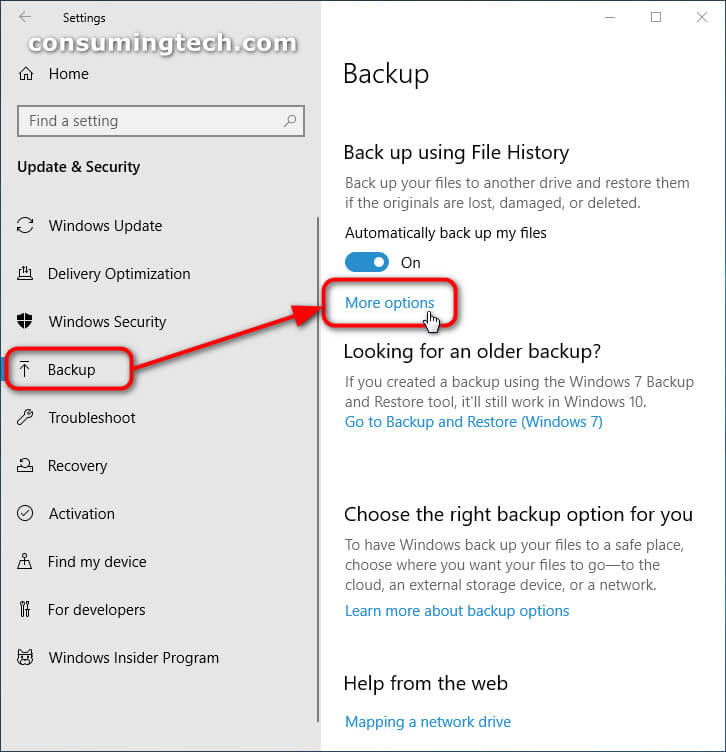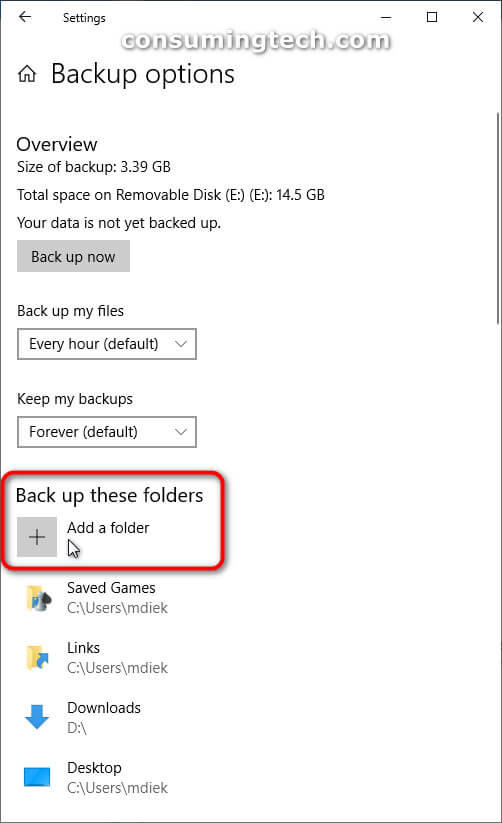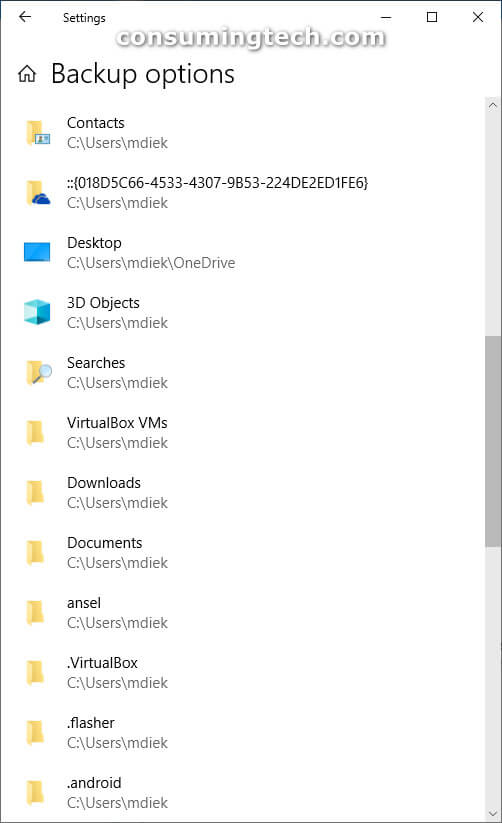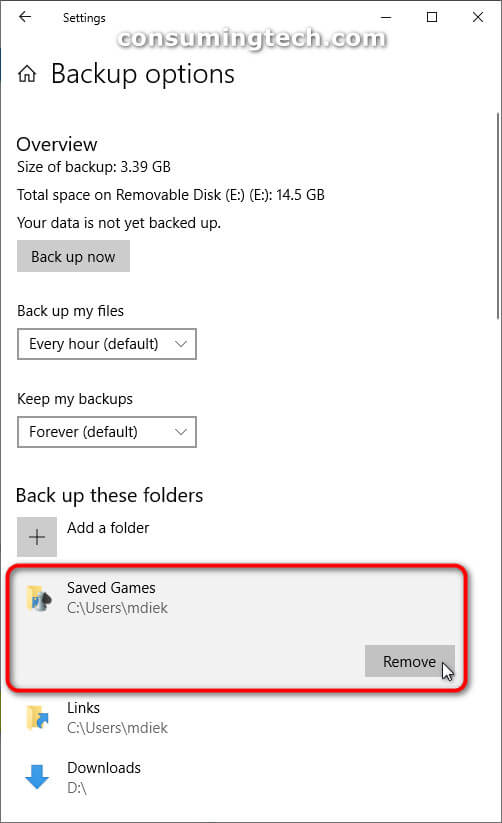Last Updated on December 24, 2022 by Mathew Diekhake
I want to use File History for my backups, but I would like the ability to add more folders to the File History backups as well as to have the chance to remove any folders I no longer want in the backups. Resolution:
Before Windows 8 was released, the Windows operating system had Backup and Restore (formerly Windows Backup and Restore Center) for taking backups. Microsoft stated that due to its low use, it would be deprecating the way users since Windows Vista had been taking backups via the traditional Backup and Restore; however, those using Windows 7 still could find the Windows 7 File Recovery Control Panel applet which allowed them to take similar backups.
File History is an application, that when turned on, will continually back up the files it finds on your desktop, in your libraries, in your Favorites folder, and your Contacts folder. If you leave File History on its default settings, it will back up these locations every hour, though you can change the amount of time you wish to elapse between backups to be as long as only once per day if you prefer. The backups can only occur for as long as you have the external hard drive or USB thumb drive connected to the computer; File History will not back up to the existing locations on the computer; it perceives them as useless locations to store backups since the point of a backup is in case your existing drives fail. File History will not ever erase files and folders that were previously saved to the drive; everything File History saves is saved to its own unique folder called “FileHistory.”
File History gives you a choice of what folders will be backed up during the File History backup. By default, you should notice quite a lot of folders that can be backed up, which can be seen when you visit the backup section of the Settings application. It is here where you can add new folders that are not already being included in the File History backups as well as remove folders from the File History backups.
The following tutorial demonstrates how to add and remove the folders that will be used during the File History backups when you are using a version of the Windows 10 operating system.
Method One: How to Add Folders to File History Backups
You can add which folders you would like to use during the File History backups from the Backup section of the Settings app. Follow these guidelines for choosing which folders you would like to add to the File History backups:
Note: There will be an automatic additional 26 characters added to the full path of the backup. The maximum full path that Windows 10 allows for is a total of 210 characters. This means any file with a path longer than 185 characters will not be backed up.
1. Open the Settings app. This tutorial shows you all the different ways in which you can open the Settings app when you are using a version of the Windows 10 operating system: How to Open Settings in Windows 10 [Tutorial]
2. From the left side of the Update and Security menu, click on Backup, and then under Back up using File History click on the More options link. (Click to enlarge the screenshot below.)
3. Scroll down until you get to the Back up these folders heading, and then click on the Add a folder icon. (Click to enlarge the screenshots below.)
You can now close the Settings app and continue using the computer.
Method Two: How to Remove Folders from File History Backups
You can choose which folders you would like to remove from the File History backups from the Backup section of the Settings app. Follow these guidelines for choosing which folders you would like to add to the File History backups:
Note: There will be an automatic additional 26 characters added to the full path of the backup. The maximum full path that Windows 10 allows for is a total of 210 characters. This means any file with a path longer than 185 characters will not be backed up.
1. Open the Settings app. This tutorial shows you all the different ways in which you can open the Settings app when you are using a version of the Windows 10 operating system: How to Open Settings in Windows 10 [Tutorial]
2. From the left side of the Update and Security menu, click on Backup, and then under Back up using File History click on the More options link. (Click to enlarge the screenshot below.)
3. Scroll down until you get to the Back up these folders heading, and then click on folder you wish to remove (e.g. Saved Games folder).
4. From the additional space beneath the folder name, click on the Remove button.
That’s all.
Related Tutorials
- How to Select Drive for File History in Windows 10 [Tutorial]
- How to Restore Files/Folders from File History in Windows 10 [Tutorial]
- How to Turn On/Off File History in Windows 10 [Tutorial]
- How to Change How Often to Save File History in Windows 10 [Tutorial]
- How to Change How Long File History Stores Backups in Windows 10 [Tutorial]
- How to Backup Files/Folders via File History in Windows 10 [Tutorial]
- How to See List of All Available System Restore Points in Windows 10 [Tutorial]
- How to Backup/Restore Network Shares and Permissions in Windows 10 [Tutorial]
- How to Backup/Restore Sticky Notes App Settings in Windows 10 [Tutorial]
- How to Delete Older Versions of File History in Windows 10 [Tutorial]
- How to Automatically Create System Restore Point on Schedule in Windows 10 [Tutorial]
- How to Reset Sticky Notes in Windows 10 from System Settings [Tutorial]
- How to Exclude Folders from File History in Windows 10 [Tutorial]
- How to Change Windows Backup Settings in Window 10 [Tutorial]
- How to Backup and Restore with Macrium Reflect [Tutorial]





